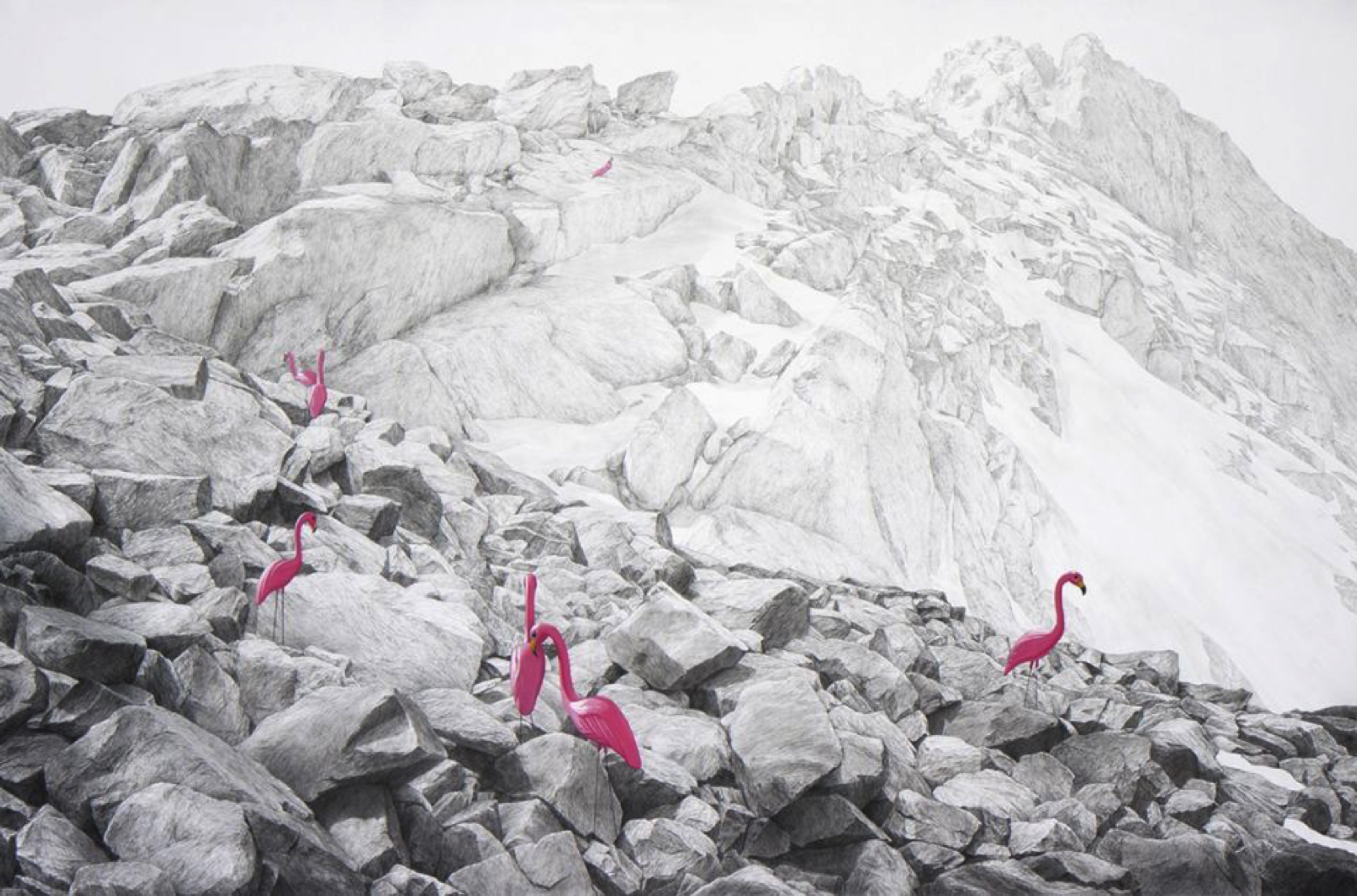Phillip Adams: Into the Wild
By: Matt Hardman, Seraphin Gallery Resident
Nestled within the isolated and frozen mountaintops of Europe, you come across a ferris wheel, a plastic dining table, playground toys, and an assembly of pink flamingos. Phillip Adams’ Matterhorn series, illustrates the vast and cold landscape of the Swiss Alps littered with light-hearted and bright artificial decor and amusements. Inspired by the Disneyland attraction, which takes the dangerous, real-life location down to size and turns it into a theme ride, Adams comments on humanity’s tendency to impose ourselves onto nature. By shrinking the Matterhorn down in scale, we exhibit a level of control over the environment. This frigid and lifeless landscape loses its power and the fear it instills in us when it is broken down and treated as an object of enjoyment. Even in his mediums, Adams reiterates the dichotomy of the natural and artificial by using charcoal for his mountain ranges and oils for his plastic, man-made objects.
 Phillip Adams, The Hunt, 2013, Charcoal, graphite, and oil on panel, 36" x 24".
Phillip Adams, The Hunt, 2013, Charcoal, graphite, and oil on panel, 36" x 24".
In The Hunt (fig. 1), Adams presents a children’s playground toy amidst a cragged and unforgiving environment. This transforms the landscape into one that is both playful and absurd. Along with placing an amusement object onto the natural world, the object itself is a plastic, blue rabbit. Another element in nature is being transformed, simplified, and commodified for human enjoyment. The title suggests that something is hunting and being hunted. The rabbit, a prey animal, is the object of the viewers’ hunt, but hunt for what exactly? The artificial animal cannot be eaten, but can be consumed and used as an object. This idea of consumption is crucial in humanity’s assertion over the natural world.
Adams’ Flamingos (fig. 2) depicts a mountain range decorated with a flock of lawn ornaments. The pink, plastic flamingo is a symbol of domestic living. Divorced from the bird itself, this object is so commonplace that it exist nearly without reference to the animal it represents. The flamingos are scattered throughout the landscape, arranged in a way that mimics live animals, wandering through their environment. The concept of lawns and land ownership is prevalent throughout this piece, commenting on the absurdity of parsing up the Earth into easily controlled plots. Plastic flamingos, although the typical in neighborhood habitats, are comical in the natural environment of the Alps.
 Phillip Adams, Flamingos, 2014, Charcoal and oil on panel,
Phillip Adams, Flamingos, 2014, Charcoal and oil on panel,
Phillip Adams is a Philadelphia based artist. He completed his BFA at the University of Georgia and his MFA at the University of Pennsylvania. Adams’s work has been exhibited at Seraphin Gallery, Arcadia University, Moore College of Art, The University of Pennsylvania, Institute of Contemporary Art, Philadelphia Museum of Art, Tiger Strikes Asteroid (co-founder), and Bridgette Mayer Gallery. He has produced several pieces of public art, including murals throughout the Philadelphia area as well as in Montreal.
Adams has recently completed his second mural in his “Industrious Light” series at Rowhouse Spirits Distillery through the City of Philadelphia Mural Arts Program and Hidden City Philadelphia. Adams has produced a 27,000 square-feet mural in collaboration with the Philadelphia Eagles and this fall he plans on finishing his third mural in the “Industrious Light” series. Seraphin Gallery congratulates Phillip Adams on his recent success and is pleased to present an upcoming solo show, opening April 22nd, 2016.

